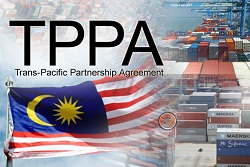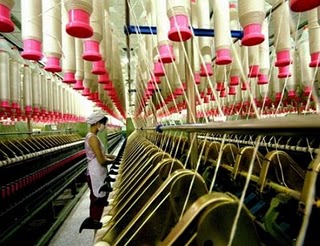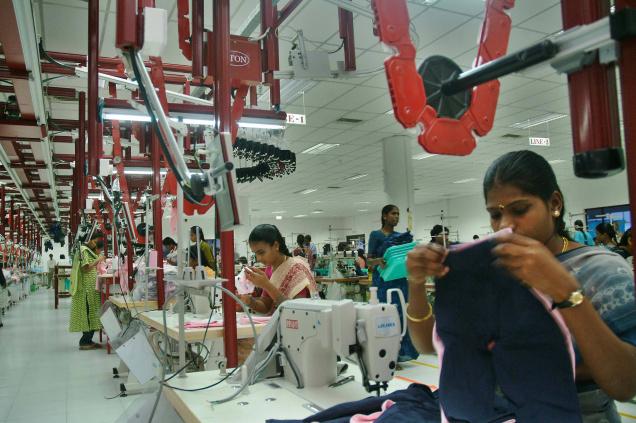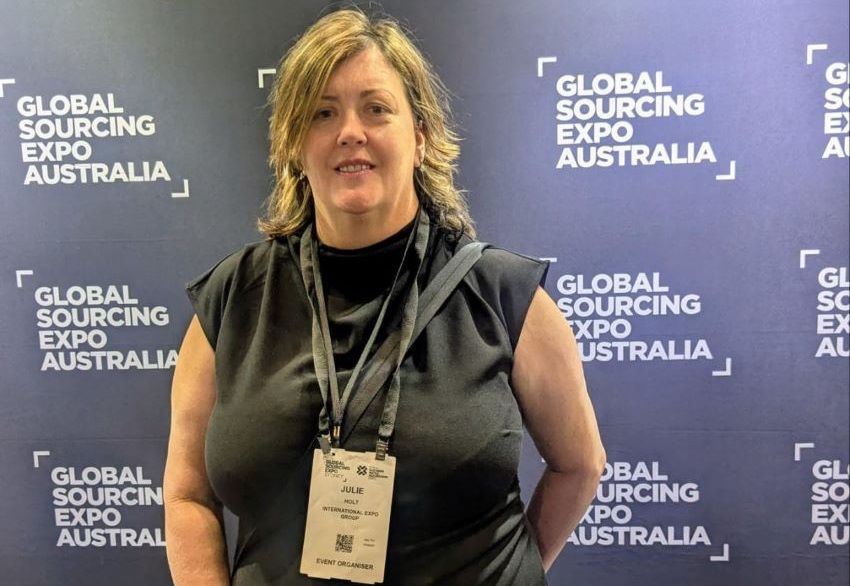FW
The textile fair BSTIM (Best Solutions in Textile Manufacturing) will be held in Spain on February 24 and 25. The exhibition aims to demonstrate the opportunities for textile manufacturing in Spain. This is the second edition of the fair. The first edition gathered more than 60 exhibitors and 1,400 visitors.
At the fair several spinners will exhibit all the range of yarns that they have in stock. Any visitor contacting a producer will be able to choose the available raw material and have that piece manufactured and ready to be sold in only 21 days. Because not all exhibitors have the capacity to deliver in this record rate of time, the emblem Fresh Fashion will be created and placed in a visible way in stands of manufacturers that offer this possibility.
Fresh Fashion is the name of a new way of working that enables producers to deliver orders quickly if there is yarn in stock. Industrial production of the textile-ready-to-wear sector grew by 2.4 per cent in 2014 in Spain as opposed to 0.9 per cent of the average industry. Growth in production went hand in hand with the growth in exports, which last year was 8.7 per cent and this year has already increased to 9.1 per cent. In 2014 in Spain the textile-ready-to-wear sector gave jobs to 5000 new professionals.
www.expodatabase.com/.../bstim-best-solutions-in-textile-manufacturing...
TRENDSPOTTING 2016: TPP is being projected as the biggest trade agreement in history, which will facilitate elimination of 18,000 tariffs on US-manufactured goods, while giving member countries cheaper access to markets across the Pacific. However, opinion is spilt about its real objective

The much talked Trans Pacific Partnership (TPP), a trendsetting trade negotiation between 12 member countries, has set the stage for changing trade equations globally. The conclusion of TPP negotiations held in Atlanta in October 2015 is set to boost business between member countries. Subsequently, it is expected to have a larger impact on fashion business globally. The immediate effect will be on countries like United States, Canada, Australia, Brunei, Japan, Chile, New Zealand, Malaysia, Singapore, Mexico, Peru and Vietnam. However, experts believe it will primarily create growth opportunities for US export sector.

From a global perspective, the treaty will have a far reaching impact as it aims to reduce, or eliminate, tariff and nontariff barriers across virtually all goods and services traded within the member countries to facilitate production and supply chain, transparency across country specific trade laws, smooth customs and border procedures, opening up of newer markets and increasing job creation.
‘Yarn Forward’ approach to boost ‘Made in America’
The TPP draft aims to facilitate economic growth through mutually beneficial, transparent trade policies between member countries, but the maximum reward will be garnered by the US. According to Julia K Hughes, President, USFIA, TPP represents an important opportunity for American fashion brands, retailers, importers, and wholesalers, who are already doing significant business in several TPP partner countries. TPP’s Textiles and Apparel chapter opens up export opportunities for ‘Made in America’ clothes, fabrics, and yarns and supports job creation in the United States. The ‘Yarn Forward’ approach requires use of yarns and fabrics from TPP countries in end products qualifying for preferential treatment under TPP. This approach aims to develop a regionally-integrated supply chain that will promote long-term growth and investment in this sector in the United States and also secures close customs cooperation among TPP countries ensuring US companies have access to temporary relief if an import surge causes, or threatens to cause, serious damage to their business.
A boost to US exports and employment
According to government trade sources, an estimated $48 million in duties are levied on US exports of textiles and apparel products in TPP markets every year and $835 million were levied in new TPP markets such as Brunei, Japan, Malaysia, New Zealand, and Vietnam in 2014. Certain textiles and apparel exports face tariffs as high as 34 per cent in new TPP markets. The report indicates that the US would be able to report duty savings in year one under TPP and savings from the new TPP markets could be as high as $932 million.
Vietnam will eliminate import taxes by 98.4 per cent and 100 per cent within four years on US textiles and apparel exports. Similarly Japan will eliminate import taxes by 99.2 per cent on US textiles and apparel exports immediately; Malaysia and New Zealand too will eliminate import taxes on 79.2 per cent and 50 per cent immediately. Subsequently, New Zealand will increase the limit to 100 per cent in seven years.
In 2014, the United States exported $394 million worth cotton fibre, yarn, and woven fabric to Vietnam, making the United States the second largest supplier of such products to Vietnam, behind China. Under TPP, Vietnam will eliminate these tariffs immediately, giving US cotton textile manufacturers a tremendous opportunity to increase exports to Vietnamese market. In 2014, the United States exported $91 million of industrial and advanced textile fabrics to Japan and exported $27.7 million of industrial and advanced textile fabrics to Malaysia. US exports currently face tariffs of up to 8.2 per cent in Japan and 20 per cent in Malaysia. Japan is the fifth largest market for the United States in these product areas, behind Canada, Mexico, Honduras, and the United Kingdom. US exports of industrial and advanced textile materials to Japan totaled $90.6 million in 2014, an increase of over 100 per cent from 2009. Under TPP, Japan will eliminate its tariffs on these products, which average 4.2 per cent. In fact, implementation of TPP ensures elimination of nearly all these tariffs immediately further giving a major boost to US exports.
TPP’s other beneficiaries
One of the major beneficiaries of TPP would be Vietnam undoubtedly as it emerges a strong garment and shoe manufacturing country. TPP will help Vietnam as it benefits from the elimination of tariffs in the US and other major importing nations. A study by PricewaterhouseCoopers (PwC) reveals Malaysia’s participation in the Trans-Pacific Partnership Agreement (TPPA) would see a rise in exports by 0.54 per cent to 0.9 per cent in 2027 mainly due to higher manufacturing exports and increase investments by an additional $136 to $239 billion over 2018-2027. It is projected to achieve a cumulative gain in GDP of $107 to $211 billion over 2018-2027.
For Australia too, benefit is significant as $9 billion of import taxes from Australian trade will be removed and the country will have access to the US sugar market. For New Zealand, 93 per cent of the tariffs will be removed with its TPP partners representing annual savings of about NZ$259 million ($168 million). The dairy industry itself will save around NZ$102 million a year; this industry accounts for about a quarter of exports.
The jury not yet out on TPP
Indeed, TPP is being projected as the biggest trade agreement in history, which will facilitate elimination of 18,000 tariffs on US-manufactured goods, while giving member countries cheaper access to markets across the Pacific. However, opinion is spilt about its real objective. Though the 12 members of the TPP agreed on a framework to liberalise trade and foster inclusive development and promote innovation across the Asia-Pacific region, critics say, TPP may hamper American manufacturing jobs, reduce environmental standards and raise drug prices in the long run. Hence, the successful conclusion of the TPP is yet to be seen.
While the textile industry has welcomed the new ATUFS announced by the Cabinet, Ludhiana's textile industry has called it “pro-corporate, anti-small sector and confusing”.
In a meeting on December 30, 2015, the Centre's Cabinet Committee on Economic Affairs (CCEA) gave a go-ahead to amend its Technology Upgradation Fund Scheme (TUFS), removing a portion that gives 30 per cent subsidy on textile machines priced between Rs 75 lakh and Rs 5 crore. However, with the new amendment forwarding 15 per cent subsidy to machines costing up to Rs 30 crores and having no mention of any additional benefit to small-time industrialists, representatives of Ludhiana's textile industry bodies have said that the move will benefit only large enterprises.
Harish Dua, President of Knitwear and Apparel Exporters' Organisation, said that it seems the decision has been taken to "benefit large enterprises". He further said that the amendments were confusing as they were not clear on whether old benefits would be withdrawn from the small sector. Bhushan Abbi, President of Home Furnishing and Textile Cluster, warned of a statewide strike over the decision.
The new scheme doses not define sub-sectors and only mentions “Apparel, Garment and Technical Textiles”. According to the scheme, only these three sectors would get 15 per cent subsidy on capital investment, subject to a ceiling of Rs 30 crores for entrepreneurs over a period of five years. Remaining sub-sectors would be eligible for subsidy at a rate of 10 per cent, subject to a ceiling of Rs 20 crores on similar lines. These sectors include standalone spinning, weaving, woolen sector, and knitting.
www.knitsandwears.com
Most of the apparel exports from Bangladesh depend upon five limited products and lack of new initiatives is putting a question mark on the country’s export competitiveness in the global market. Industry experts are sceptical about the sustainability of exports in future.
Currently, more than 78 per cent of the sector's earnings come from shipment of only five items namely shirt, trouser, jacket, T-shirt and sweater though Bangladesh exports more than 30 types of products. The country reported $25.49 billion from knit and woven exports in fiscal year 2014-15 while only five items contributed $20.04 billion, according to data of the Export Promotion Bureau and the Bangladesh Garment Manufacturers and Exporters Association (BGMEA).
The total export earnings stood at $31.198 billion in last fiscal while garment accounted for 81.71 per cent of the total, according to data. Overseas sales of local garment products are also mainly limited to four major destinations-the EU, US, Canada and Japan.
Industry experts are of the opinion that the sector’s dependency over cotton-based products and lack of effective efforts for product diversification and new market exploration as well as shortage of specialised skilled workforce, poor infrastructure and entrepreneurs' unwillingness to take risk are some of the factors responsible for the limited product exports.
The experts seek government's policy support to change the entire export scenario, including opening of new missions, branding of local products, and cash support for potential sectors.
Since the existing four-year wage agreement is about to end in January, various textile associations in the knitwear town of Tirupur have decided to hold joint negotiations with the labour unions to fix revised monthly wages.
Till now, South India Hosiery Manufacturers’ Association (SIHMA) and a few other associations were jointly signing a wage pact with labour unions and Tirupur Exporters’ Association (TEA) along with a few other associations used to sign a separate agreement. However, now all these associations plan to ink a joint wage pact to negotiate with the labour unions in a better way and also to bring equality in the wage scales across the sector.
A preliminary meeting of representatives of SIHMA, Tirupur Exporters’ Association and four other associations was organised recently to explore the possibilities. These associations have also asked leading trade unions such as CITU, AITUC, MLF, LPF, ATP and INTUC to come up with a joint set of demands before beginning the actual wage revision talks.
Trade unions on the other hand are looking forward to a considerable rise in monthly wages along with other benefits like house rent and medical allowance. www.tea-india.org
The Ministry of Textiles has raised concerns over an Environment Ministry's proposal to mandate almost all the textile units to reduce their effluent discharge to zero. Outgoing Textiles Secretary, S K Panda has written a letter to the ministry saying that the proposed standards are "too stringent" and it may lead to several textile units closing their operations.
The proposed standards by the Environment Ministry seeks to lay down zero liquid discharge for textile processing units where water discharge is greater than 25 KLD per day. Panda has said in his letter that the domestic processing industry is largely unorganised and consists of small and medium units and the proposed norms are stringent in terms of capital investment and it would also have high recurring expenditure. He has asked the ministry to implement norms in a phased manner.
The Textiles Ministry has held several meetings with the industry representatives, textile research associations and Indian Institute of Technology on the issue and a committee has been formed to study the existing technologies of effluent treatment. Panda said that in the short-term best available technology can be introduced and for the long-term R&D would be pursued for developing cleaner and more cost effective options. Texmin.nic.in
India's textile exports are getting affected on account of the US legislation for federal procurement, which stipulates sourcing of raw materials from the designated countries or domestic suppliers, Ficci said. The industry body has submitted a representation to resolve this issue to the Ministry of Textiles and Ministry of Commerce & Industry.
"Ficci has requested the Government of India to take up the issue either bilaterally or multilaterally with the US government to resolve the issue amicably," it stated. Indian textile exporters have said that the buyers or companies based in the US supplying to their government departments and agencies have stopped sourcing raw materials from countries like India, since the country is not a part of the General Services Administration (GSA) Schedule Contract.
The GSA is responsible for supporting several federal agencies in the US with basic functions, including procurement services. The Buy American Act, the US federal acquisition process is based on preferential treatment of US-made products. Manufacturers are considered as US products if manufactured domestically and the cost of local components is more than 50 per cent of the overall cost of all components.
Under certain conditions however, the Buy American Act may be waived. The Trade Agreements Act of 1979 (TAA) gives the President authority to waive Buy American Act requirements for certain procurements. So far it has been waived for eligible products in acquisitions covered by the WTO Government Procurement Agreement, some relevant free trade agreements (FTA), as well as for least-developed countries. As per the TAA, all products listed on the GSA Schedule Contract be manufactured or "substantially transformed" in a "designated country".
The designated countries, as per the GSA Schedule, consist of World Trade Organization Government Procurement Agreement Countries, Countries having Free Trade Agreement with the US, Least Developed Countries and Countries based in the Caribbean-Basin. And India does not fit into any of the mentioned criteria prohibiting American companies from sourcing from the country.
www.ficci.com
"The new scheme specifically targets employment generation and exports in apparel and garment industry. It will provide employment to women in particular and increase India’s share in global exports; promote technical textiles for export and employment; promote conversion of existing looms to better technology looms for improvement in quality and productivity; encourage better quality in processing industry and checking need for import of fabrics by the garment sector."

Benefits from new ATUFS
The new scheme specifically targets employment generation and exports in apparel and garment industry. It will provide employment to women in particular and increase India’s share in global exports; promote technical textiles for export and employment; promote conversion of existing looms to better technology looms for improvement in quality and productivity; encourage better quality in processing industry and checking need for import of fabrics by the garment sector.

Rahul Mehta, President, CMAI feels, the new scheme is a relief to the entire textile sector, especially because the RR-TUFS was in a limbo and no unique ID, which is the formal sanction under the scheme, has been issued after September 2014. “Allocating nearly Rs 13,000 crores (1985 million USD )for clearing the committed liabilities will help in clearing the backlog pending for issuance of UIDs and also the large number of so called 'left out cases' that have been pending for a decision for nearly four years,” he said.
AEPC Chairman, Virender Uppal believes ATUFS will provide the much needed thrust for the expansion and growth of the apparel industry along with the employment generation in India. Reiterating similar views, Shishir Jaipuria, Chairman, FICCI Textiles and Technical Textiles Committee says, “The approval has come as a great relief to the industry especially when the exports were declining in textile and apparel sector. The focus on employment generation and export under the new TUFS by encouraging apparel and garment industry and promotion of technical textile sector, is indeed a welcome step which will help in furthering the cause of Make in India."
Under the ATUFS, all cases pending with the Office of Textile Commissioner which are complete in all respects shall be provided assistance under the ongoing scheme and the new scheme will be given prospective effect.
‘Make in India’ gets renewed attention
The amended scheme is expected to boost ‘Make in India’ initiative in the textiles sector and attract investment to the tune of one lakh crore rupees, and create over 30 lakh jobs. A budget provision of Rs 17,822 crores (2721million USD) has been approved, of which Rs 12,671 crores (1935million USD) is for committed liabilities under the ongoing scheme, and Rs 5,151 crores (787 million USD) for new cases under ATUFS.
Office of Textile Commissioner (TXC) is being reorganised; its offices shall be set up in each state. Officers of the TXC shall be closely associated with entrepreneurs for setting up the industry, including processing proposals under the new scheme, verifying assets created jointly with the bankers and maintaining close liaison with the State Government agencies.
M Senthilkumar, Chairman, The Southern India Mills’ Association (SIMA) welcoming the timely move by the government, said that the ATUFS would enable the textile industry to ease their financial position and also plan investments. He appreciated the announcement of ease of doing business and also reorganisation of the Office of the Textile Commissioner so that the TxC could closely associate with the entrepreneurs, bankers and state governments and implement the projects on a fast track mode.
The implementation of the scheme would be executed and monitored online under iTUFS, launched in April, 2015. Under the new scheme, there will be two broad categories: apparel, garment and technical textiles, where 15 per cent subsidy would be provided on capital investment, subject to a ceiling of 30 crores rupees (4.581million USD)for entrepreneurs over a period of five years, and remaining sub-sectors would be eligible for subsidy at a rate of 10 per cent, subject to a ceiling of Rs 20 crores (3.054 millionUSD).
Thanking the government for the extra focus provided to the highly labour intensive apparel segment and the highly potential technical textiles by stipulating a higher capital assistance of 15 per cent against 10 per cent available to other segments, Mehta said that the apparel industry was not very capital intensive, but given the sub-scale operation of production facilities in this segment in the country and the need to achieve economies of scale for competing with large units in countries like China, Bangladesh and Vietnam, the higher assistance to the apparel segment will prove to be highly beneficial in pushing both employment and exports in our textiles sector.
Texmin.nic.in
The textile sector reviewed a number of initiatives implemented through 2015 to boost the health of the entire sector. At its year-end review, the Textiles Ministry listed the initiatives it undertook in 2015.
The handicrafts sector benefited a lot under the Government's revised handicrafts schemes and strategy, which included infrastructure development, such as a Common Facility Centre in every cluster, development of design and training, through schemes under Office of DC (Handicrafts), direct assistance to artisans, such as online assistance through their bank accounts and linking up with market (including e-commerce) with participation of private sector.
The handlooms sector also received a major thrust with the Government launching 'India Handloom' brand for promoting high value handloom products with new design, zero defect in fabrics, zero effect on environment and assurance to consumer to about genuineness and quality of the product. As far as the power loom sector is concerned, the Textiles Ministry launched a pilot scheme to upgrade existing plain powerlooms to semi-automatic looms by providing additional attachments and to enable the power loom weavers to improve the production and quality of fabrics to face the competition in domestic and international markets.
In the silk sector, production targets for the year 2014-15 were achieved, the review said. The amount of Rs 297.58 crores allocated for the year 2014-15 for plan developmental activities has been fully utilised. For the year 2015-16, an allocation of Rs178.10 crores has been approved, against which, an amount of Rs 145.74 crores has been released as on November 3, 2015.
According to the review, to safeguard interests of domestic cotton growers, a well-planned, largest ever Minimum Support Price operation was carried out by the Cotton Corporation of India in the 2014-2015 cotton season, in all 11 cotton producing states. This operation was highly successful, with procurement crossing 86 lakh bales up to March 30, 2015.
In the wool sector, the Central Wool Development Board, Jodhpur (CWDB) has implemented different schemes for development of the sector with various schemes such as Pashmina promotion programme, Sheep & Wool Improvement Scheme and Angora Wool Development scheme in Himachal Pradesh and Manipur. To safeguard interests of producers and manufacturers of jute and jute products estimated at about 4.35 million families, the Government in January 2015, approved orders for mandatory packaging of food grains in jute bags and subsidy to Jute Corporation of India to support MSP operations in jute. The validity of the order was later extended up to December 31, 2015.
Texmin.nic.in
Stretchline Holdings is the world’s largest branded narrow fabric manufacturer. Since 1996 it has a state-of-the-art plant with a world class dye house. Now, Stretchline is using robotic technology to develop more innovative products through application of silicone material, for compression or grip, to textiles for fashion, medical, sportswear and garments.
The robot allows the company to accurately program rotation speeds and positions for applying silicone on a garment. Stretchline has firmly established itself as the world’s leading brand of narrow performance fabric for intimate and active apparel. The company has manufacturing plants in Sri Lanka, China, Indonesia, Mexico, Honduras, US and UK which are supported by marketing offices in the US, UK and Hong Kong, enabling the group to provide needle point support to the world’s leading lingerie and active wear brands.
Stretchline is a three way joint venture between Stretchline (UK), MAS Holdings (Sri Lanka) and Brandot International Ltd (USA) that was first established in 1996. Stretchline UK is a product of the merger of two elastic giants Charnwood Elastic Group (UK) and Tubbs Elastic Group (UK) that can boast of over 150 years’ experience in the industry.












